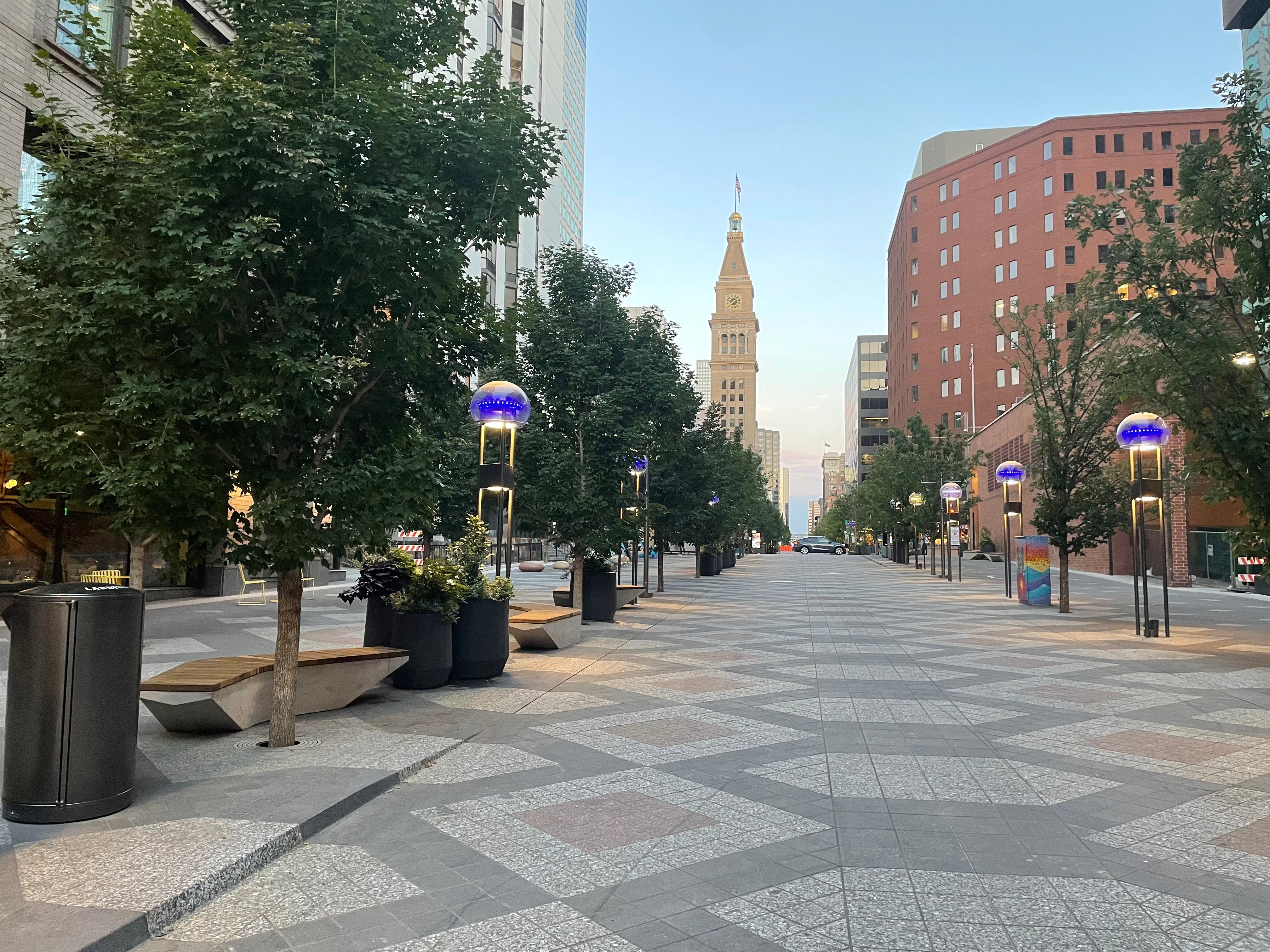Going Underground in the Mile High City
Denver employs an advanced below-ground infrastructure to handle stormwater and promote urban tree growth.
A Portland firm gets ahead of the storm, with sustainability and style.
Stormwater management is an increasing concern in modern landscaping. Climate patterns are shifting, flooding is intensifying, and development areas are expanding. As a result, landscape professionals must increasingly consider how substantial amounts of water will move through a property to a desired destination. Planning ahead to mitigate flood and storm damage has become as essential as achieving a certain design aesthetic or ensuring plants are regionally appropriate.
Beyond abating damage, stormwater management is also central to creating a sustainable landscape design. Designing systems that slow, capture, infiltrate and filter stormwater allows water to be utilized as the resource it is. Techniques including bioswales, rain gardens, green roofs and infiltration basins can slow, infiltrate, and redistribute water back into the soil and local water table. These smart water management strategies create landscapes that can handle a wide variety of rain scenarios.
Consider Portland, OR. With a reputation for overcast skies, Portland averages about 153 rainy days per year. At the time of this writing, the city had just suffered a storm of such heavy rainfall from an “atmospheric river” that Portland Parks & Recreation reported nearly 80 “tree-related” emergencies on city property and landslides were occurring in various locations. One OregonLive.com commentary humorously carried the headline: “Portland’s ceaseless rain is a reminder that February is a truly terrible month.”
So perhaps it’s no surprise that the landscape professionals at Blossom are finding inventive ways to integrate stormwater
management solutions into the brand’s ecological principles and streamlined, modern aesthetic. “Portland has a problem with our combined sewer system,” explains Blossom Designer Dorsey Kilbourn. “And so when we have a heavy rain, we end up with sewage in our river. So, it’s the city’s priority—and it’s Blossom’s priority beyond that—for plants to ‘keep’ the water that falls on that property.” She adds, “As stewards of the landscape, we have a responsibility to retain water on-site as much as possible, which is especially important in areas with combined sewer systems.”

For years, sewage overflows during heavy rain events were common in Portland, but since 2011, a Stormwater Management Plan (SWMP) has increased efforts to reduce stormwater in the system. The result? 2024 was one of only a few years on record without a sewage overflow into the river.
Due to this dynamic, Blossom’s approach to stormwater management is twofold. “While there are immediate benefits to any landscape and local ecology, in Portland there is extra incentive to remove stormwater from the sewer system,” comments Owner Todd Blossom.
This function, however, can still live happily with form. “Water management is practical at its core and doesn’t have to sacrifice design,” says Blossom. “In fact, landscape
design can and should integrate multifunctional, multitiered stormwater management techniques into the landscape design process. This enhances both visual appeal, local ecology and property value for your people and place.”
Often, the most severe and impactful flooding is due to inadequate drainage, improper use of non-native plants, and urban development that disrupts natural water runoff. To rectify these issues, understanding the topography of a property to be designed— as well as its surroundings—is key. With a keen eye and some calculations, a designer can determine areas of a property that are most likely to flood and apply strategies to address vulnerabilities at the outset of the design process.
In one particular Blossom project, Kilbourn describes how her team faced multiple onsite challenges ranging from unforeseen grading challenges to heavy volumes of water from impermeable surfaces. “Obviously, [the clients] didn’t come to me and say, ‘OK, make a plan for where all the water on our property is gonna go,’” she explains. “I had to do that.”
As stewards of the landscape, we have a responsibility to retain water on-site as much as possible.
Striving for a balance of the needed functionality and desired aesthetic, the Blossom design team held to the permaculture adage: “The problem is the solution.” Indeed, water movement can be beautiful. “Taking inspiration from a traditional Japanese moon gate and the Japanese aesthetic sought by the client, a new feature and focal point was born into the landscape,” explains Kilbourn.
While not always practical, here a carefully chosen rain chain is used to move water from a slotted conveyance in a portal wall to the ground, where it is collected and directed. In this particular project a bioswale, doubling as a dry creek bed, helps convey water through the landscape, even passing under a custom foot bridge. The design allows water to percolate and infiltrate along the way, eventually reaching a dry well system where it feeds back into the local water table. Now, over 600 gallons of water are managed on site with every 1 inch of rain, resulting in a landscape rich in interest and ecological value.
The Importance of Native Plants
It should be mentioned that native plants are another essential tool in the Blossom team’s water management strategies. In the project above, Dorsey said the landscape needed “a simple and cohesive palette of plants for year-round appeal, ecological value, drought-tolerance, and staggered bloom times.” These are the hallmarks of resilient native plants.
Because native plants have evolved in the Portland area, they are naturally adapted to the local climate and, when placed properly, will be healthier and better able to withstand anomalies like flood and drought events. Deeper root systems improve soil structure and capacity to take in and hold excess water. Native plants also support local biodiversity, add ecological health to properties, and minimize the need for irrigation and maintenance, which align with the goals of sustainable landscaping.
Overall, Blossom’s landscape designs and techniques are rooted in a Watershed Wise approach to stormwater management. Techniques like this help manage water in the landscape while also building soil, reducing erosion, and preventing toxic runoff from entering city drains and river systems. The result is a more resilient landscape functioning as its own mini watershed helping to regenerate the land, water, and air.
All photos courtesy of Dorsey Kilbourn, Blossom
LEARN MORE
Listen to an interview with Angelique Robb and Todd Blossom here.

1 Assess the Landscape’s Topography
Identify slopes, low areas, and places where water naturally pools. This insight is essential for developing tailored solutions.
2 Incorporate Permeable Surfaces
Use permeable pavers, gravel pathways, and rain gardens that allow water to infiltrate the soil, rather than running off.
3 Opt for Native Plants
Native vegetation not only manages water better but also boosts biodiversity. Choose plants that suit your area’s climate and require minimal maintenance.
4 Design for Aesthetics & Functionality
Integrate functional features that also add visual appeal, such as rain chains, decorative water channels, and Japanese-inspired landscaping elements.
5 Adopt a Watershed Wise Approach
Designing with Watershed Wise principles ensures your landscape supports water conservation, reduces runoff, and prevents pollution from entering local water bodies.

Denver employs an advanced below-ground infrastructure to handle stormwater and promote urban tree growth.

Midway, Kentucky-Based Lawn Care Service Focuses on Increasing Efficiency & Service Quality

Why do so many small business owners wait until it’s too late to plan for succession and transition?